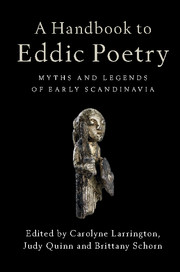Book contents
- Frontmatter
- Contents
- List of illustrations
- List of contributors
- Translations and abbreviations of the titles of eddic poems
- Introduction
- 1 The transmission and preservation of eddic poetry
- 2 Traditions of eddic scholarship
- 3 The editing of eddic poetry
- 4 The dating of eddic poetry
- 5 Eddic performance and eddic audiences
- 6 Eddic poetry and mythology
- 7 Eddic poetry and the religion of pre-Christian Scandinavia
- 8 Eddic poetry and heroic legend
- 9 Place names in eddic poetry
- 10 Eddic poetry and the imagery of stone monuments
- 11 Eddic poetry and archaeology
- 12 Eddic modes and genres
- 13 Eddic metres
- 14 Eddic style
- 15 Kennings and other forms of figurative language in eddic poetry
- 16 Alliterative lexical collocations in eddic poetry
- 17 The representation of gender in eddic poetry
- 18 The reception of eddic poetry
- Consolidated bibliography
- Index
Introduction
Published online by Cambridge University Press: 05 August 2016
- Frontmatter
- Contents
- List of illustrations
- List of contributors
- Translations and abbreviations of the titles of eddic poems
- Introduction
- 1 The transmission and preservation of eddic poetry
- 2 Traditions of eddic scholarship
- 3 The editing of eddic poetry
- 4 The dating of eddic poetry
- 5 Eddic performance and eddic audiences
- 6 Eddic poetry and mythology
- 7 Eddic poetry and the religion of pre-Christian Scandinavia
- 8 Eddic poetry and heroic legend
- 9 Place names in eddic poetry
- 10 Eddic poetry and the imagery of stone monuments
- 11 Eddic poetry and archaeology
- 12 Eddic modes and genres
- 13 Eddic metres
- 14 Eddic style
- 15 Kennings and other forms of figurative language in eddic poetry
- 16 Alliterative lexical collocations in eddic poetry
- 17 The representation of gender in eddic poetry
- 18 The reception of eddic poetry
- Consolidated bibliography
- Index
Summary
In the mythological eddic poem Hymiskviða the gods order the sea-ruler Ægir to entertain them all at a feast. Ægir responds with the claim that he does not possess a cauldron big enough for the purpose, and Týr and Þórr set off to find a suitable vessel at the home of Týr's mother in Jǫtunheimar (‘the lands of the giants’). Their success means that véar hverian vel skulu drekka ǫlðr at Ægis eitt hǫrmeitið (‘the gods will drink well ale at Ægir's every winter’, Hym 39/4–8). The most capacious of cauldrons is appropriated from Hymir, whose hospitality is distinctly chilly, and brought to a hall where its contents can delight gods and elves alike. The mode of eddic poetry is just such a gigantic kettle, an all-encompassing container for the Old Norse myths and heroic legends which froth, bob, and jostle together within it, whether as substantial whole poems, fragmentary verse sequences, or single lausavísur (‘free-standing verses’). When in 1955 the English poet Philip Larkin eschewed drawing on the ‘common myth-kitty’ for the inspiration for his poems (Larkin 1955, 78), he was explicitly rejecting the recent Modernist poetic practice of employing wide-ranging cultural allusions. Yet Larkin's metaphor for all that he refused has found resonance for those who write about traditional story. Thus, this Handbook engages closely with the ‘myth-kitty’, the shared resources of traditional knowledge that find their form within the accommodating mode of eddic poetry: the myths and legends of the Old Norse–Icelandic tradition. These stories are primarily preserved in the two great anthologies of eddic poetry, the Codex Regius of the Poetic Edda (GKS 2365 4°) and AM 748 I a 4°, but a number of mythological and heroic eddic poems were written down in other manuscripts (see Clunies Ross, Chapter 1 in this Handbook). These poems, or poems very much like them, provided the important Icelandic writer Snorri Sturluson (1179–1241) with the basis for composing his Edda, a manual of poetics into which he incorporated a systematic overview of Old Norse myth and offered summarised versions of some of the more important legendary cycles. Had the Codex Regius manuscript not come to light in 1643 and been preserved in Copenhagen for future generations, if we were without our most important eddic manuscript, our understanding of Old Norse myth and legend would be immeasurably the poorer.
- Type
- Chapter
- Information
- A Handbook to Eddic PoetryMyths and Legends of Early Scandinavia, pp. 1 - 11Publisher: Cambridge University PressPrint publication year: 2016
- 2
- Cited by

